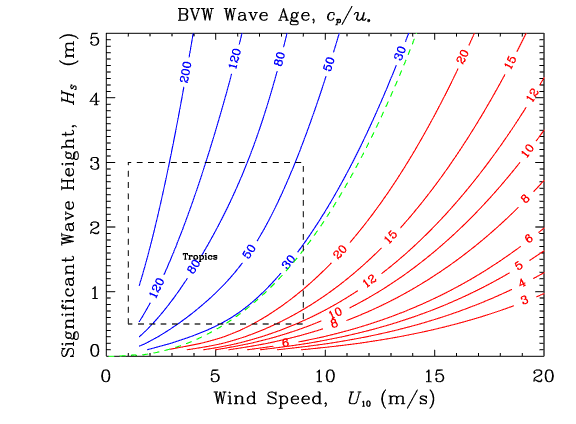Dr. Mark A. Bourassa, COAPS/FSU, Tallahassee FL 32306-2840
With David M. Legler and James J. O'Brien
There is little doubt that air-sea fluxes are dependent on sea state; however, the exact nature of this dependency remains controversial. If a sea state dependency is presumed (e.g., the HEXOS result; Smith et al., 1992), then the dependence on long waves can be modeled. One such model is the Bourassa-Vincent-Wood (BVW) coupled flux and sea state model. The HEXOS result specifies sea state in terms of wave age (cp/u*; where cp
is the phase speed of the dominant waves, and u* is the friction velocity) or phase speed. With a coupled flux and sea state model it is possible to express sea state in other terms. Sea state proxies currently used in the BVW model are wave age, phase speed of the dominant waves, period of the dominant waves, significant wave height, and significant slope (the ratio of significant wave height to the wavelength of the dominant waves). Of these proxies for sea state, only significant wave heights are observed (through buoys and altimetry) and publicly available. Satellite derived significant wave heights can be used in conjunction with observed winds (e.g., from scatterometers) to improve the accuracy of derived fluxes, by removing the typical assumptions a prescribed drag coefficient or wind-wave local equilibrium.
The modeled results are shown herein. In all examples the mean wind direction is assumed to be parallel to the direction of wave propagation. The BVW model can be used for more general cases; but known weaknesses in the HEXOS sea state parameterization lead to errors for non-parallel flow with U10 < 7 m s-1. In each of the following examples,
red contours indicate rising seas, blue indicates falling seas, and the green line indicates local equilibrium. The shaded region indicates the regime most likely to be effected by weaknesses in the HEXOS sea state dependency.First examined is the variation in wave age, the common proxy for sea state, as a function of wind speed and significant wave height. For any wind speed, the stress will be greater over a rougher surface, and smaller over a smoother surface. Consider 'rougher' or 'smoother' relative to the surface for
local wind-wave equilibrium. Falling seas tend to have long smooth swells, whereas rising seas have relatively short sharp waves. The spatial density of these waves is also relatively low for long smooth waves, and relatively high for short sharp waves. Consequently, the stress (and hence friction velocity) is smaller over falling seas and larger over rising seas. Falling seas have wave ages greater than equilibrium values (for the same wind speed), and rising seas have values smaller than equilibrium values.
The change in stress from the
local equilibrium value at the same wind speed (% relative to the equilibrium value) can be large for rising seas. It is relatively small for falling seas; however, swell (falling seas) dominates most of the tropical oceans resulting is a spatially systematic reduction in the stress. The upturn at low wind speeds occurs because of mixing induced by capillary waves, and the interaction between this mixing and the orbital motion of the long waves. At low and moderate wind speeds (U10 < 7 m s-1), capillary waves dominate the stress, and this interaction dominates the influence of sea state on stress. Consequently, the limitations of the HEXOS sea state parameterization appears to have little influence for U10 < 7 m s-1, except perhaps for extremely old seas.
The drag coefficient (x103) may be more familiar to many readers.

Note that increases in significant wave height, while holding the wind speed constant, reduce the stress and drag coefficients. This result is contrary to most people's intuition; however, it is consistent with observations. The reason for this result is apparent in the plot of the significant slope. As Significant slope (HS /
l, where l is the wavelength of the dominant waves) is shown as a function of wind speed and significant wave height. As significant wave height increases, the wavelength of the dominant waves increases more rapidly. Recall than falling seas have relatively long smooth waves, and rising seas have relatively short sharp waves.
This dependence of stress on sea state also influences other fluxes such as sensible and latent heat transfer. Stress is proportional to the square of the friction velocity, where as sensible and latent heat fluxes are proportional to the friction velocity. Consequently, the sensitivity to sea state for sensible and latent heat is roughly half that of stress. The sea state dependence of the latent heat flux is shown below as the change in latent heat flux (for air/sea moisture differences of 1 g kg-1) as a function of wind speed and significant wave height. The difference is approximately proportional to this difference, which is typically in the range of 3 to 6 g kg-1. Spatially and temporally systematic modifications to heat fluxes, due to differences in sea state, could have a substantial impact on the results of oceanographic and meteorological models. The extent of the differences and the impact are under investigation.

References
Bourassa, M. A., D. G. Vincent, W. L. Wood, 1998: A flux parameterization including the effects of capillary waves and sea state. Journal of the Atmospheric Sciences, in press.
Last Updated: Novemver 4, 1998


